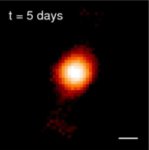 Observations of gas expanding from a nova explosion, reported in Nature this week, offer a rare glimpse of a nova.
Observations of gas expanding from a nova explosion, reported in Nature this week, offer a rare glimpse of a nova.
A nova is an explosion on the surface of a white dwarf. Novae are much smaller and less violent than supernovae, and do not lead to the disruption of the star, but rather just eject a surface layer of gas into space. Interferometric observations of Nova Delphini 2013, discovered in August 2013, enable Gail Schaefer and colleagues to measure the size, shape, speed and distance of the ejected gas. These observations are possible thanks to the CHARA array in California, USA, which has the high spatial resolution capable of capturing the earliest stages of the expansion of the ejecta. They find that the ejecta changes during the early stages of the nova expansion, starting as a uniform core, but spreading out to what might be a bipolar structure as early as the second day after the explosion. Combining measurements of the expansion rate and speed of the outflow, the authors calculate that the nova is around 4.54 kiloparsecs (1 parsec is around 3.26 light years) away.
Article publié le 31 octobre 2014 sur le site de Nature
Cet article est un premier résultat issu de mesures dans le domaine infra-rouge avec l’interféromètre CHARA. Une équipe du laboratoire Lagrange (UNS - CNRS - OCA), composée de O. Chesneau, D. Mourard, A. Meilland, N. Nardetto, Ph. Stee, a contribué via une campagne d’observation sur CHARA et son instrument visible VEGA, depuis l’Observatoire de la Côte d’Azur. Ces données dans le domaine visible feront l’objet d’un article ultérieur.


